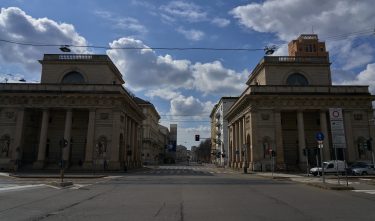Amid the deluge of virus-related information, I noticed three reports in particular. Reports about a new Milan, Berlin and possibly a new Netherlands.
Firstly, one about the design mecca Milan, which is also known as one of the unhealthiest cities in Europe. In the pre-corona era, the city had a heavy shuttle service that did not exactly improve the quality of life. But just like many other cities, Milan is now experiencing how alternative forms of mobility and living together, as a result of virus-related measures, are becoming visible within the urban spaces. Cyclists and pedestrians are playing a more significant role as users of roads and public spaces. This new use of space offers a beautiful perspective following the darkness into which Milan has recently subsided. And it offers a view of a different future. This perspective is gaining momentum with the knowledge that earlier attempts to tempt residents away from their cars have failed. With the plan ‘Strade Aperte’, the city now wants to consolidate the enforced changes and standardise them. Kilometres of streets will be transformed to accommodate cycling and walking. As such, it seems that Milan will be successful in breaking through the spatial status quo and making the existing urban conditions fluid again.
 1
1
 2
2
A similar thing is happening in Berlin. Here, however, it is not the acute crisis that is the instigator of change, but rather anticipation of the period afterwards. Although the current limitations mean that very few Berliners are using the green spaces currently available, their value has become clear. The city council has therefore made a commitment to create more green spaces and to use the existing ones differently. As well as an enhanced green infrastructure, it is striking that they also want to open up the existing ‘greenish’ spaces – such as old cemeteries, sports parks and allotment complexes. In a similar way to Milan, Berlin is also choosing transformation and to change the existing spaces. It could be summed up as the softening of spaces, of boundaries and of previously defined functions. Aside from the tragic reason behind all this, meaningful spatial developments are actually taking place that, certainly in the first instance, amount to rearranging and reordering. A certain kind of softness.
The third striking report deals with the Dutch government’s announcement that the central government will strive to play a greater role in the design and layout of our country. After years of decentralisation and the delegation of spatial responsibilities to local authorities, this is a striking correction. It indicates that the government realises that the relatively sparse space in our country in relation to the size and impact of certain spatial transformations demands a stronger guiding policy. It remains to be seen how this intention will actually take shape. We can hope that The Hague will not solely fall back on the ‘old style’ of hard and strict spatial planning, but will acknowledge the tactics embraced by Milan and Berlin.
It is true that design is not explicitly mentioned in any of the three cited reports. But its role is unavoidable. Neither the transformation of the street profiles in Milan, nor the enhanced greening of Berlin, nor a national spatial policy can be put in place without the imagination of designers. However, design is not yet the top priority. Despite all the best ideas and intentions of the profession, a certain amount of modesty is required here. But contributions will undoubtedly and in the second instance be sought when the definite consequences of the crises have to be made tangible. In no uncertain terms, design will follow the crisis.
JaapJan Berg, DDA jury member and committee chair in the category ‘Habitat’